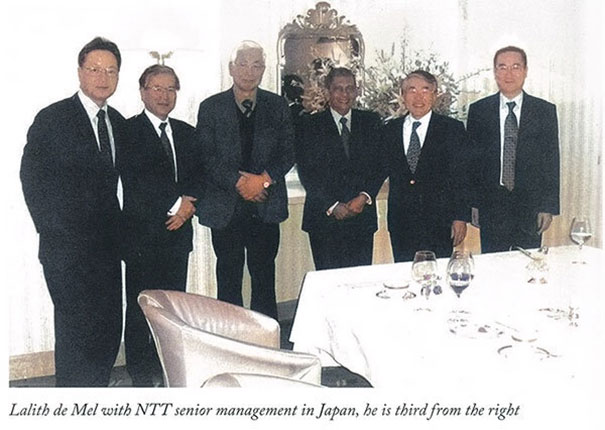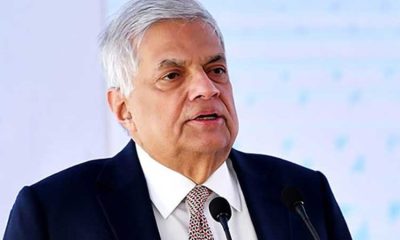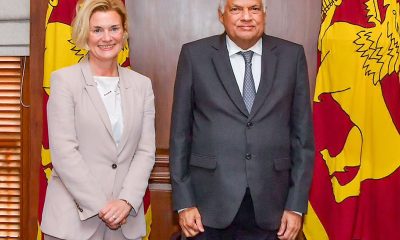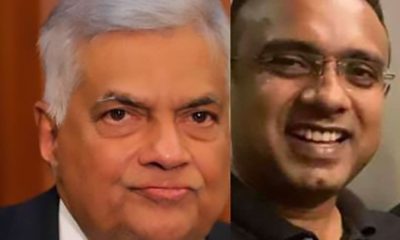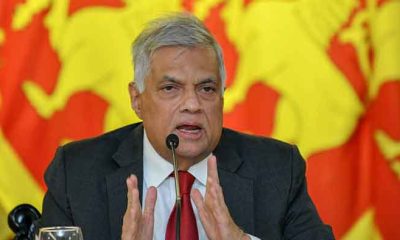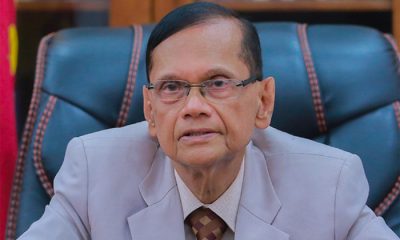Features
Appointed Chairman of SLT and required to carry a pistol by my side
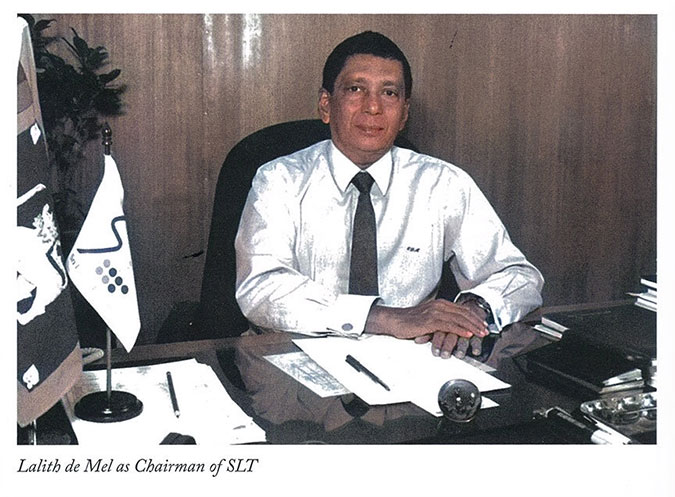
Three attempts on life of corruption prober who was finally stabbed dead
(Excerpted from the autobiography of Lalith de Mel)
“I had never met her when Ronnie Pieris sent a message saying that she would like to meet me on my next visit to Sri Lanka. I met her at Temple Trees on a Sunday afternoon. I got her broad, charming smile and I thought that was a good start. I wondered at the time whether this charming and good-looking women had any brains to go with her looks. In the two hours that followed I got the answer. She certainly did.
At the end of a long discussion, she came straight to the point. She said: ‘I would like to congratulate you. I have heard about your achievements. When you retire, I hope you will come and help my Government.’ So as to keep the ball in play, without making a commitment, I mumbled in a vague sort of way that I would be happy to do so.
We had talked for two hours, and she did most of the talking. Being economical with words was not her forte. I was amazed at her grasp of the key strategic issues and how well she articulated them. I was also surprised at her sound grasp of the economics of growth.
In her model for growth, infrastructure was important and one of her major concerns was that infrastructure projects were moving slowly and this was impacting the prospects for long-term growth. She wanted my help to address this issue. She said: ‘Before you go back, meet the Secretary to the Treasury. I have asked him to tell you about the current and planned infrastructure projects and the current problems on implementation.’
I left with a promise that I would get in touch when I had retired.
A few weeks later I got a message from her Secretary saying she wanted to meet me as soon as possible. I was flying to Singapore the next week and I stopped off on the way. She reminded me of her previous discussion with me about the general importance of developing infrastructure and the key importance of telecommunication infrastructure. She said she was not convinced that we could do this by ourselves, and had entered into a joint venture with NTT of Japan. She was very agitated that this was all falling apart. That was my first glimpse of the angry CBK.
She said that the Japanese were having disagreements with the Government, that the Chairman was not getting on with the Minister and that the trade unions were not getting on with anyone.
She wanted me to take on the role of Chairman of Sri Lanka Telecom immediately. I explained that I would need to think about it and consult my wife, and then if I wanted to, I would need permission from the Board of Reckitt & Colman PLC as I was still working for them. I promised to revert in a week. When I returned to London, one evening fortified with a few whiskies to stimulate the brain, I had a long think about it.
I had a vague ambition to spend time in Sri Lanka post-retirement and to use my knowledge and experience to do something useful for my country. Taking on a major public sector role had not even been considered. However I had to make a quick decision. The Government and CBK had a major problem. Should I do it or provide some excuse and run away from it? In the end I said to myself that if I was really interested in helping my country, I should not run away from this challenge. So I got approval from my Board to spend two weeks a month in Sri Lanka and then told CBK that I would take on the assignment.
That was the start of working for seven years with CBK and the Government of Sri Lanka. I performed many roles during this period and they will be described later. The most important one had no title and was performed until her term expired. That was becoming a team with Dr. P.B. Jayasundera and Mano Tittawella and being the think-tank and the key support team for CBK.
Her final election victory was defeating Ranil Wickremesinghe’s UNP Government. In the run-up to this election she asked me to come on the National List and when she won to be her Minister of Finance. Without any hesitation I thanked and declined. Dr. P.B. Jayasundera and Mano Tittawella were also present and they suggested I think about it.
I said that I was sure that I would be unhappy and uncomfortable working in the atmosphere that prevailed in Parliament and did not wish to take on the role. I said I would be much more useful and helpful to her by being a part of her backroom team and taking on any assignments as a part of that role. That is what I did until the end of her term. It was a fascinating period of my life. I got a great insight into the political scene in the country.
Working closely with CBK, the President of the country, was also a fascinating experience. We agreed and disagreed at times, and were occasionally put in the dark hole as PB, Mano and I called it. If you seriously annoyed her, she did not contact you for some time, but then it was back to smiles.
My basic input was developing processes for better governance of the country. Concepts were debated and as she was very intelligent she understood what we were pursuing and always made a major contribution and often brought in a dimension we had not appreciated.
A new idea cannot be enforced by Presidential edict alone. It had to be channeled through Cabinet papers and Cabinet decisions so as to ensure compliance. She was excellent at handling this process.
At the end of her tenure, she kindly bestowed the Deshamanya title upon me. In the, citation it was in recognition of the honour to Sri Lanka by getting on the Main Board of a top 100 company in the UK and in recognition of my contribution in various roles in Sri Lanka. We remain good friends.
When I accepted the role of Chairman of SLT, I had decided that I would work free and accept no salary when working for the Government and this I did in respect of all my Government appointments. I also paid for my air fare from London and never made a single claim for entertainment or any other expenses. When I was working for the Government and afterwards, there has never been any allegation of fraud or abuse of office.
Saving Sri Lanka Telecom from bankruptcy
When I arrived from the UK, I went immediately to SLT to meet the Managing Director. There was a short-lived pleasant surprise. The Japanese Managing Director was Hide Kamitsuma, who had been with me at Harvard Business School 10 years previously. I knew him reasonably well at Harvard. I soon discovered that he was a great friend of Hemasiri Fernando, who had been removed as Chairman, creating the vacancy to which I was appointed.
Kamitsuma told me that Hemasiri had filed a Fundamental Rights case and the relief he was seeking was not compensation but reinstatement as Chairman. I asked him whether he thought that was a good idea. The Japanese turn a nice shade of pink when they drink and he turned the same colour after my question, smiled, shrugged his shoulders and mumbled something vague on the lines of it would be okay if he came back. Aha! Kamitsuma was likely to be more foe than friend.
That afternoon there was an event to welcome the new Chairman. There was a frisson of tension in the air. Kamitsuma’s speech was not overly welcoming. The Trade Union Leader’s speech was more threatening than welcoming. The rest of the Board and Senior Managers were present but I did not know any one of them. None of them came up and said, ‘Sir don’t worry we are all with you.’ Perhaps Hemasiri Fernando was well-liked and many like Kamitsuma may have been sad that he was removed.
I was not fazed by this scenario and did not for a moment think I should take the next plane back to London. The task as I saw it was the simple one of successfully running yet another business, and I had run many, many businesses in the past.
Understanding the business and the people
After a few days I had a game plan. The first priority was to establish a rapport with the trade unions, the next was to get to know and establish a friendly relationship with the senior management team, and then to get a clear understanding of the finances of SLT. It all worked out well. The unions were pleased that I met them immediately as I took over, and that I treated them with respect and were prepared to listen to them.
In the course of time I played the old trick when they brought up a problem. I would ask them to think about it for four weeks and work out a solution and I promised to do the same and said that we would discuss it when we met in four weeks. More often than not, the problem disappeared. I had no strikes, no unrest and good support from the unions, but nothing comes free and there was a price to pay. They claimed that senior managers were corrupt and had made money and wanted them removed and they said they would help to provide the evidence.
I knew that that the `komis kakkas,’ as the President called them, were fluttering around. One even offered me a bribe. I knew it was not sensible to dive into exploring the fraud that had taken place before I arrived, and the wise and prudent course was to promise no more corruption in future. The unions would not go along and insisted I take action against those had made money. The choice was trade union unrest or enquiry and action on bribery. I had to go down the bribery route. It led to dire consequences.
Getting the business on an even keel
There was a lot of fat in debtors; I squeezed a lot of cash from there. They had not leveraged creditors and got breathing space by negotiating delayed payments. Cash had been going out for capital projects faster than it came in. I pruned, phased and delayed the capital projects. Very soon we moved away from the brink of bankruptcy. In a year we had a good P&L, the balance sheet looked much better, hurdle rates for capital project and cash payback requirements were firmly established and the Japanese technical staff were given a crash course on cash flows and cash management.
The Japanese NTT staff working for SIT were all excellent technical people, all very competent and doing a grand job, but they were babes in the wood when it came to finance. My guess was that they had performed senior jobs in Japan in one of the main regional divisions of NTT, and their task had been to provide excellent service. The management of cash, providing funds for capital projects and pricing, etc., was a head office function and did not become one of their skills.
Things were going so well at SIT and it was possible to entertain a thought of playing golf early evenings. Two things destroyed this nice idea. I had to take over as Chairman of the Board of Investment and the trade unions were insistent about removing those who had made money.
Pursuing corruption
This was always an exercise fraught with danger. But danger perhaps did not press too heavily on the mind, as due to the LTTE one had got used to living with danger and ignoring it. SLT was a top LTTE target. There was an Army platoon stationed at SLT and it also had its own armed security staff. But if a suicide lorry got through and stormed the main gate, my office was 25 yards from it.
The Head of Administration, Sriyantha Fernando, was tasked with probing past corruption. It is a long Agatha Christie detective story about finding those guilty of corruption. Instead of narrating it, let me just say that evidence was found and the Head of Procurement, a very senior manager, was interdicted. Then the fun and games started. A grenade was thrown at the portico of Sriyantha’s assistant’s house and a car damaged with no injury to people. A few weeks later a grenade was thrown at the porch of Sriyantha’s house in Moratuwa. Again a car was damaged with no injury to anyone.
A month later as Sriyantha was coming home, at the top of the lane someone fired a 9mm pistol at the front of the vehicle. The driver kept on driving and the hitman then fired at the side and finally at the rear of the vehicle. The driver took one shot on his leg and Sriyantha took nine shots on his body, but fortunately none hit his head or chest. The driver bravely turned the vehicle round and drove to Kalubowila Hospital. He survived.
Carrying a 9mm repeater pistol
The President was informed and Minister Mangala Samaraweera was informed and he called the IGP, etc. The Head of Security at SLT was a General and a retired head of the Army. He and a DIG Police came to my office the next day and solemnly announced that I would be the next target as I had initiated this whole process of investigating corruption. He put a 9mm 20 shot repeater pistol on my desk (which became my constant companion for the next five or six years) and said, ‘You must always carry this’.
They both said, ‘You must also learn to shoot well.’ I was familiar with shotguns and rifles in the shooting fishing days of my youth but not with automatic pistols. It was then to the Army shooting range for the next 10 days until my instructor thought I could shoot well.
I was then exposed to an amazing piece of strategic thinking by the Police who had by then been instructed by the President and Secretary Defence to give me full protection. The top Police officer responsible for protecting me met me, and this is what he said: ‘Sir, we can’t prevent you being killed if they (whoever they are) want to kill you. We have armed guards at your residence and nobody can come and kill you at your home.
‘The risk we can do nothing about is when you are traveling by car. Even if we have an armed officer sitting in front, a man on a motorcycle can come up alongside and shoot you. But you can protect yourself. Tomorrow we have asked all the Directors and Senior Managers to come to the Army range office to discuss security.
We will then tell them to come and watch the Chairman shoot and we will also importantly tell the drivers to come and see the Chairman shooting. Sir, you must shoot very well. The drivers will then talk about it at SIT and the whole of SIT will know that you shoot well. The underworld will also come to know as they will be monitoring your movements and they will know that you carry a pistol.
‘What we will do with this exercise is convey to any potential hit-man that there is a 50-50 chance that he will get killed if he attempts to kill you. They do not generally pursue a hit if there is a risk of getting killed. That man does not know you and has no personal dislike of you. It is just another job. He wants to do it and then go on to other jobs. He does not want to get killed.’
I was asked to carry the gun everywhere. To keep it by my side in the car and if any motorcycle came alongside, to raise the gun and make it visible. They said they may test the risk. Two innocent motorcyclists nearly got themselves killed by running into traffic on the other side when they saw me pointing a gun at them. The hard part was to condition my mind to shoot without hesitation and instantly if a motorbike came alongside and the man on the pillion took a gun out. I needed to learn to concentrate.
Every time I got in the car, I said a few times to myself. `If a man with a pistol comes alongside, shoot.’ When I was sure I could do that, the threat of getting killed receded in my mind like not worrying about the LTTE suicide bomber ramming the SLT gates. No one with a gun came alongside, and I could not test my resolve to shoot without any hesitation. Shame!
Postscript
Sriyantha Fernando recovered and was kept in a safe house in Colombo for some time until he was fit to travel. Then NTT gave him a job in Singapore. The Police made no significant progress in finding the man who shot him or those who hired him. The Police said: ‘Keep the gun with you always until we find the culprits.’ Time rolled on and the gun was not always carried. Then Sriyantha came back to Sri Lanka. Within a month he was stabbed and killed at home! It was back to carrying the pistol.
Features
The heart-friendly health minister

by Dr Gotabhya Ranasinghe
Senior Consultant Cardiologist
National Hospital Sri Lanka
When we sought a meeting with Hon Dr. Ramesh Pathirana, Minister of Health, he graciously cleared his busy schedule to accommodate us. Renowned for his attentive listening and deep understanding, Minister Pathirana is dedicated to advancing the health sector. His openness and transparency exemplify the qualities of an exemplary politician and minister.
Dr. Palitha Mahipala, the current Health Secretary, demonstrates both commendable enthusiasm and unwavering support. This combination of attributes makes him a highly compatible colleague for the esteemed Minister of Health.
Our discussion centered on a project that has been in the works for the past 30 years, one that no other minister had managed to advance.
Minister Pathirana, however, recognized the project’s significance and its potential to revolutionize care for heart patients.
The project involves the construction of a state-of-the-art facility at the premises of the National Hospital Colombo. The project’s location within the premises of the National Hospital underscores its importance and relevance to the healthcare infrastructure of the nation.
This facility will include a cardiology building and a tertiary care center, equipped with the latest technology to handle and treat all types of heart-related conditions and surgeries.
Securing funding was a major milestone for this initiative. Minister Pathirana successfully obtained approval for a $40 billion loan from the Asian Development Bank. With the funding in place, the foundation stone is scheduled to be laid in September this year, and construction will begin in January 2025.
This project guarantees a consistent and uninterrupted supply of stents and related medications for heart patients. As a result, patients will have timely access to essential medical supplies during their treatment and recovery. By securing these critical resources, the project aims to enhance patient outcomes, minimize treatment delays, and maintain the highest standards of cardiac care.
Upon its fruition, this monumental building will serve as a beacon of hope and healing, symbolizing the unwavering dedication to improving patient outcomes and fostering a healthier society.We anticipate a future marked by significant progress and positive outcomes in Sri Lanka’s cardiovascular treatment landscape within the foreseeable timeframe.
Features
A LOVING TRIBUTE TO JESUIT FR. ALOYSIUS PIERIS ON HIS 90th BIRTHDAY

by Fr. Emmanuel Fernando, OMI
Jesuit Fr. Aloysius Pieris (affectionately called Fr. Aloy) celebrated his 90th birthday on April 9, 2024 and I, as the editor of our Oblate Journal, THE MISSIONARY OBLATE had gone to press by that time. Immediately I decided to publish an article, appreciating the untiring selfless services he continues to offer for inter-Faith dialogue, the renewal of the Catholic Church, his concern for the poor and the suffering Sri Lankan masses and to me, the present writer.
It was in 1988, when I was appointed Director of the Oblate Scholastics at Ampitiya by the then Oblate Provincial Fr. Anselm Silva, that I came to know Fr. Aloy more closely. Knowing well his expertise in matters spiritual, theological, Indological and pastoral, and with the collaborative spirit of my companion-formators, our Oblate Scholastics were sent to Tulana, the Research and Encounter Centre, Kelaniya, of which he is the Founder-Director, for ‘exposure-programmes’ on matters spiritual, biblical, theological and pastoral. Some of these dimensions according to my view and that of my companion-formators, were not available at the National Seminary, Ampitiya.
Ever since that time, our Oblate formators/ accompaniers at the Oblate Scholasticate, Ampitiya , have continued to send our Oblate Scholastics to Tulana Centre for deepening their insights and convictions regarding matters needed to serve the people in today’s context. Fr. Aloy also had tried very enthusiastically with the Oblate team headed by Frs. Oswald Firth and Clement Waidyasekara to begin a Theologate, directed by the Religious Congregations in Sri Lanka, for the contextual formation/ accompaniment of their members. It should very well be a desired goal of the Leaders / Provincials of the Religious Congregations.
Besides being a formator/accompanier at the Oblate Scholasticate, I was entrusted also with the task of editing and publishing our Oblate journal, ‘The Missionary Oblate’. To maintain the quality of the journal I continue to depend on Fr. Aloy for his thought-provoking and stimulating articles on Biblical Spirituality, Biblical Theology and Ecclesiology. I am very grateful to him for his generous assistance. Of late, his writings on renewal of the Church, initiated by Pope St. John XX111 and continued by Pope Francis through the Synodal path, published in our Oblate journal, enable our readers to focus their attention also on the needed renewal in the Catholic Church in Sri Lanka. Fr. Aloy appreciated very much the Synodal path adopted by the Jesuit Pope Francis for the renewal of the Church, rooted very much on prayerful discernment. In my Religious and presbyteral life, Fr.Aloy continues to be my spiritual animator / guide and ongoing formator / acccompanier.
Fr. Aloysius Pieris, BA Hons (Lond), LPh (SHC, India), STL (PFT, Naples), PhD (SLU/VC), ThD (Tilburg), D.Ltt (KU), has been one of the eminent Asian theologians well recognized internationally and one who has lectured and held visiting chairs in many universities both in the West and in the East. Many members of Religious Congregations from Asian countries have benefited from his lectures and guidance in the East Asian Pastoral Institute (EAPI) in Manila, Philippines. He had been a Theologian consulted by the Federation of Asian Bishops’ Conferences for many years. During his professorship at the Gregorian University in Rome, he was called to be a member of a special group of advisers on other religions consulted by Pope Paul VI.
Fr. Aloy is the author of more than 30 books and well over 500 Research Papers. Some of his books and articles have been translated and published in several countries. Among those books, one can find the following: 1) The Genesis of an Asian Theology of Liberation (An Autobiographical Excursus on the Art of Theologising in Asia, 2) An Asian Theology of Liberation, 3) Providential Timeliness of Vatican 11 (a long-overdue halt to a scandalous millennium, 4) Give Vatican 11 a chance, 5) Leadership in the Church, 6) Relishing our faith in working for justice (Themes for study and discussion), 7) A Message meant mainly, not exclusively for Jesuits (Background information necessary for helping Francis renew the Church), 8) Lent in Lanka (Reflections and Resolutions, 9) Love meets wisdom (A Christian Experience of Buddhism, 10) Fire and Water 11) God’s Reign for God’s poor, 12) Our Unhiddden Agenda (How we Jesuits work, pray and form our men). He is also the Editor of two journals, Vagdevi, Journal of Religious Reflection and Dialogue, New Series.
Fr. Aloy has a BA in Pali and Sanskrit from the University of London and a Ph.D in Buddhist Philosophy from the University of Sri Lankan, Vidyodaya Campus. On Nov. 23, 2019, he was awarded the prestigious honorary Doctorate of Literature (D.Litt) by the Chancellor of the University of Kelaniya, the Most Venerable Welamitiyawe Dharmakirthi Sri Kusala Dhamma Thera.
Fr. Aloy continues to be a promoter of Gospel values and virtues. Justice as a constitutive dimension of love and social concern for the downtrodden masses are very much noted in his life and work. He had very much appreciated the commitment of the late Fr. Joseph (Joe) Fernando, the National Director of the Social and Economic Centre (SEDEC) for the poor.
In Sri Lanka, a few religious Congregations – the Good Shepherd Sisters, the Christian Brothers, the Marist Brothers and the Oblates – have invited him to animate their members especially during their Provincial Congresses, Chapters and International Conferences. The mainline Christian Churches also have sought his advice and followed his seminars. I, for one, regret very much, that the Sri Lankan authorities of the Catholic Church –today’s Hierarchy—- have not sought Fr.
Aloy’s expertise for the renewal of the Catholic Church in Sri Lanka and thus have not benefited from the immense store of wisdom and insight that he can offer to our local Church while the Sri Lankan bishops who governed the Catholic church in the immediate aftermath of the Second Vatican Council (Edmund Fernando OMI, Anthony de Saram, Leo Nanayakkara OSB, Frank Marcus Fernando, Paul Perera,) visited him and consulted him on many matters. Among the Tamil Bishops, Bishop Rayappu Joseph was keeping close contact with him and Bishop J. Deogupillai hosted him and his team visiting him after the horrible Black July massacre of Tamils.
Features
A fairy tale, success or debacle

Sri Lanka-Singapore Free Trade Agreement
By Gomi Senadhira
senadhiragomi@gmail.com
“You might tell fairy tales, but the progress of a country cannot be achieved through such narratives. A country cannot be developed by making false promises. The country moved backward because of the electoral promises made by political parties throughout time. We have witnessed that the ultimate result of this is the country becoming bankrupt. Unfortunately, many segments of the population have not come to realize this yet.” – President Ranil Wickremesinghe, 2024 Budget speech
Any Sri Lankan would agree with the above words of President Wickremesinghe on the false promises our politicians and officials make and the fairy tales they narrate which bankrupted this country. So, to understand this, let’s look at one such fairy tale with lots of false promises; Ranil Wickremesinghe’s greatest achievement in the area of international trade and investment promotion during the Yahapalana period, Sri Lanka-Singapore Free Trade Agreement (SLSFTA).
It is appropriate and timely to do it now as Finance Minister Wickremesinghe has just presented to parliament a bill on the National Policy on Economic Transformation which includes the establishment of an Office for International Trade and the Sri Lanka Institute of Economics and International Trade.
Was SLSFTA a “Cleverly negotiated Free Trade Agreement” as stated by the (former) Minister of Development Strategies and International Trade Malik Samarawickrama during the Parliamentary Debate on the SLSFTA in July 2018, or a colossal blunder covered up with lies, false promises, and fairy tales? After SLSFTA was signed there were a number of fairy tales published on this agreement by the Ministry of Development Strategies and International, Institute of Policy Studies, and others.
However, for this article, I would like to limit my comments to the speech by Minister Samarawickrama during the Parliamentary Debate, and the two most important areas in the agreement which were covered up with lies, fairy tales, and false promises, namely: revenue loss for Sri Lanka and Investment from Singapore. On the other important area, “Waste products dumping” I do not want to comment here as I have written extensively on the issue.
1. The revenue loss
During the Parliamentary Debate in July 2018, Minister Samarawickrama stated “…. let me reiterate that this FTA with Singapore has been very cleverly negotiated by us…. The liberalisation programme under this FTA has been carefully designed to have the least impact on domestic industry and revenue collection. We have included all revenue sensitive items in the negative list of items which will not be subject to removal of tariff. Therefore, 97.8% revenue from Customs duty is protected. Our tariff liberalisation will take place over a period of 12-15 years! In fact, the revenue earned through tariffs on goods imported from Singapore last year was Rs. 35 billion.
The revenue loss for over the next 15 years due to the FTA is only Rs. 733 million– which when annualised, on average, is just Rs. 51 million. That is just 0.14% per year! So anyone who claims the Singapore FTA causes revenue loss to the Government cannot do basic arithmetic! Mr. Speaker, in conclusion, I call on my fellow members of this House – don’t mislead the public with baseless criticism that is not grounded in facts. Don’t look at petty politics and use these issues for your own political survival.”
I was surprised to read the minister’s speech because an article published in January 2018 in “The Straits Times“, based on information released by the Singaporean Negotiators stated, “…. With the FTA, tariff savings for Singapore exports are estimated to hit $10 million annually“.
As the annual tariff savings (that is the revenue loss for Sri Lanka) calculated by the Singaporean Negotiators, Singaporean $ 10 million (Sri Lankan rupees 1,200 million in 2018) was way above the rupees’ 733 million revenue loss for 15 years estimated by the Sri Lankan negotiators, it was clear to any observer that one of the parties to the agreement had not done the basic arithmetic!
Six years later, according to a report published by “The Morning” newspaper, speaking at the Committee on Public Finance (COPF) on 7th May 2024, Mr Samarawickrama’s chief trade negotiator K.J. Weerasinghehad had admitted “…. that forecasted revenue loss for the Government of Sri Lanka through the Singapore FTA is Rs. 450 million in 2023 and Rs. 1.3 billion in 2024.”
If these numbers are correct, as tariff liberalisation under the SLSFTA has just started, we will pass Rs 2 billion very soon. Then, the question is how Sri Lanka’s trade negotiators made such a colossal blunder. Didn’t they do their basic arithmetic? If they didn’t know how to do basic arithmetic they should have at least done their basic readings. For example, the headline of the article published in The Straits Times in January 2018 was “Singapore, Sri Lanka sign FTA, annual savings of $10m expected”.
Anyway, as Sri Lanka’s chief negotiator reiterated at the COPF meeting that “…. since 99% of the tariffs in Singapore have zero rates of duty, Sri Lanka has agreed on 80% tariff liberalisation over a period of 15 years while expecting Singapore investments to address the imbalance in trade,” let’s turn towards investment.
Investment from Singapore
In July 2018, speaking during the Parliamentary Debate on the FTA this is what Minister Malik Samarawickrama stated on investment from Singapore, “Already, thanks to this FTA, in just the past two-and-a-half months since the agreement came into effect we have received a proposal from Singapore for investment amounting to $ 14.8 billion in an oil refinery for export of petroleum products. In addition, we have proposals for a steel manufacturing plant for exports ($ 1 billion investment), flour milling plant ($ 50 million), sugar refinery ($ 200 million). This adds up to more than $ 16.05 billion in the pipeline on these projects alone.
And all of these projects will create thousands of more jobs for our people. In principle approval has already been granted by the BOI and the investors are awaiting the release of land the environmental approvals to commence the project.
I request the Opposition and those with vested interests to change their narrow-minded thinking and join us to develop our country. We must always look at what is best for the whole community, not just the few who may oppose. We owe it to our people to courageously take decisions that will change their lives for the better.”
According to the media report I quoted earlier, speaking at the Committee on Public Finance (COPF) Chief Negotiator Weerasinghe has admitted that Sri Lanka was not happy with overall Singapore investments that have come in the past few years in return for the trade liberalisation under the Singapore-Sri Lanka Free Trade Agreement. He has added that between 2021 and 2023 the total investment from Singapore had been around $162 million!
What happened to those projects worth $16 billion negotiated, thanks to the SLSFTA, in just the two-and-a-half months after the agreement came into effect and approved by the BOI? I do not know about the steel manufacturing plant for exports ($ 1 billion investment), flour milling plant ($ 50 million) and sugar refinery ($ 200 million).
However, story of the multibillion-dollar investment in the Petroleum Refinery unfolded in a manner that would qualify it as the best fairy tale with false promises presented by our politicians and the officials, prior to 2019 elections.
Though many Sri Lankans got to know, through the media which repeatedly highlighted a plethora of issues surrounding the project and the questionable credentials of the Singaporean investor, the construction work on the Mirrijiwela Oil Refinery along with the cement factory began on the24th of March 2019 with a bang and Minister Ranil Wickremesinghe and his ministers along with the foreign and local dignitaries laid the foundation stones.
That was few months before the 2019 Presidential elections. Inaugurating the construction work Prime Minister Ranil Wickremesinghe said the projects will create thousands of job opportunities in the area and surrounding districts.
The oil refinery, which was to be built over 200 acres of land, with the capacity to refine 200,000 barrels of crude oil per day, was to generate US$7 billion of exports and create 1,500 direct and 3,000 indirect jobs. The construction of the refinery was to be completed in 44 months. Four years later, in August 2023 the Cabinet of Ministers approved the proposal presented by President Ranil Wickremesinghe to cancel the agreement with the investors of the refinery as the project has not been implemented! Can they explain to the country how much money was wasted to produce that fairy tale?
It is obvious that the President, ministers, and officials had made huge blunders and had deliberately misled the public and the parliament on the revenue loss and potential investment from SLSFTA with fairy tales and false promises.
As the president himself said, a country cannot be developed by making false promises or with fairy tales and these false promises and fairy tales had bankrupted the country. “Unfortunately, many segments of the population have not come to realize this yet”.
(The writer, a specialist and an activist on trade and development issues . )

